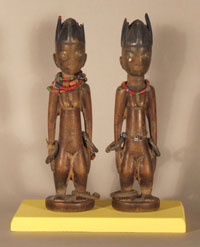Artworks
- Sculpture
- Nigerian
- Yoruba peoples
- African, 20th century
- Ere Ibeji (A Pair of Twin Female Figures)
- ca. 1910
- Wood, beads, paint and metal
- 10 1/4 x 3 5/16 x 2 7/16 inches
- Yoruba peoples of Nigeria and the Republic of Benin have one of the highest rates of twin births in the world. Twins, considered a great blessing to their family, are thought to have divine protection and extraordinary capabilities. There is the practice among many Yoruba peoples of memorializing a deceased twin in the form of a sculptural figure. Hence, when a twin died the family sought the guidance of a priest who often directed the parents to commission a commemorative carving representing the deceased child.
"Ere ibeji" or twin figures, are not portraits, rather they embody aesthetic ideals that balance realism and abstraction in sculptural forms. They are sometimes passed down from one generation to the next in order to honor the spirit of the twin and are the focus of religious and family activities. - Transfer from the Department of Art, Michigan State University, Gift of Mr. and Mrs. Dean N. Glick
- 99.4.1-2
- Exhibition History
